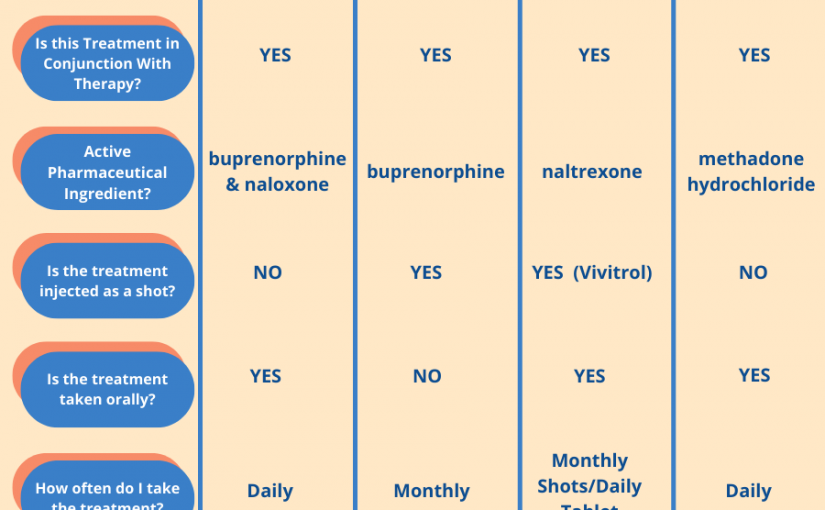Sublocade Vs. Suboxone
Opioid addiction is a deadly disease that’s sweeping the nation. Every day, hundreds of people die from accidental overdoses. In 2021, the U.S. experienced almost 107,000 drug overdose deaths. More than 80,000 deaths are related to opioids, and almost 88% of fatal overdoses result from synthetic opioids.
Opioids are a class of drugs that include the illegal drug heroin and pain relievers available legally by prescription, such as oxycodone, hydrocodone, codeine, morphine, and many others. Many people can take these medications without developing an addiction. However, as many as 19% of people who take legal opioid pain relievers develop an addiction. It destroys lives, families, and communities.

Suboxone and Sublocade are both medications medical professionals use to treat opioid dependence. Both prescription drugs contain buprenorphine, which helps reduce withdrawal symptoms and cravings. When comparing Sublocade Vs. Suboxone, there are some critical differences between the two drugs that you should know before deciding which medication is right for you.
What is Sublocade?
Sublocade is a brand-name, injectable medication used to treat moderate-to-severe opioid addiction in people aged 18 and older. It’s a long-acting form of buprenorphine, which means it lasts for weeks or months at a time. Buprenorphine treatment may help people stop using other opioids like heroin and pain relief pills.
Sublocade contains buprenorphine (a partial agonist), which activates the opioid receptors in your brain. This reduces the risk of over-stimulation and overdose.

Sublocade’s unique structure minimizes opioid withdrawal symptoms and cravings without producing the same “high” that other opioids do. Many people find Sublocade is an effective treatment for opioid dependence because it makes it easier to stick to their recovery plan. A healthcare provider administers a once-monthly injection of Sublocade. It’s a subcutaneous injection that doesn’t go into a vein. Instead, it goes under the skin.
Addiction specialists have been using Sublocade to treat patients with opioid dependence since 2017. Sublocade was proven more useful in clinical trials than other buprenorphine products for reducing opioid use and withdrawal symptoms.
NOT IN ILLINOIS? NO PROBLEM!
Visit our partner, Community Medical Services, to see if they have a location near you!
Are you looking for Sublocade Treatment?
Brightside has addiction treatment clinics across Chicagoland. Get an appointment as early as today.
Who Can Take Sublocade?
Physicians only approve Sublocade’s buprenorphine extended-release treatment for adults who have been taking other buprenorphine products, such as Suboxone, for at least seven days. You must also be stable on your current dose of buprenorphine before you can start taking Sublocade.
This is because Sublocade contains a higher concentration of buprenorphine than other products. If you take Sublocade too soon, you may experience severe withdrawal symptoms. It can also be dangerous if you take Sublocade while you’re still using other opioids. This increases your risk of overdose.
Sublocade treatment isn’t right for everyone. You shouldn’t take Sublocade if you’re allergic to buprenorphine or other active ingredients in the medication.
Sublocade may interact with other daily medications you’re taking, so it’s important to tell your doctor about all the prescription medication and over-the-counter drugs, vitamins, and supplements you’re using. This includes other buprenorphine products, as well as antidepressants, antipsychotics, different opioids, and sedatives.
Sublocade may also interact with other substances, such as alcohol. Drinking alcohol while taking Sublocade can increase your risk of overdose and death.
Can Pregnant Women Take Sublocade?
Sublocade is not recommended for use by pregnant or breastfeeding women or children under the age of 18. Studies are also unavailable for patients 65 or older, so Sublocade use in this age group is not recommended. Also, tell your doctor if you’re pregnant or planning to become pregnant.

How Does Sublocade Work?
Sublocade works by reducing withdrawal symptoms and cravings associated with opioid misuse. It does this by binding to the same brain receptors that opioids like heroin and prescription painkillers attach to. This action helps prevent the highs and lows associated with opioid use disorder.

Who Can Prescribe Sublocade?
Only healthcare professionals who have completed the training can only prescribe Sublocade. If you’re interested in Sublocade, your first step should be to speak with your primary care or addiction specialist. A Brightside Clinic practitioner can work with you to find the right addiction treatment options. We’ll discuss the benefits and complete a Sublocade risk evaluation before approving your treatment plan.
What are the Risks of Sublocade?
Sublocade is a safe and effective medication when used as directed. However, there are some risks associated with the drug, including:
- Serotonin syndrome
- Injection site reactions
- Dizziness
- Nausea and vomiting
Some of these side effects can cause serious harm. Before starting treatment, you’ll need to discuss the risks and benefits of Sublocade with your medical provider.
What is Serotonin Syndrome?
Serotonin syndrome is a rare but potentially life-threatening condition that can occur when taking certain medications, including Sublocade.
Symptoms of serotonin syndrome include:
- Agitation
- Hallucinations
- Rapid Heart Rate
- High Blood Pressure

This is a medical emergency if you experience any of these symptoms during your treatment.
Who is at Risk of Serotonin Syndrome?
Anyone taking Sublocade is at risk. However, certain people are more likely to experience this condition, including those who:
- Have a history of serotonin syndrome
- Take other medicines that increase serotonin levels in the body
- Have liver disease
- Are older than 65
These aren’t the only risk factors for serotonin syndrome. Be sure to talk to your provider regarding risks before starting medication-assisted treatment.
Injection Site Reactions
Patients receive Sublocade injections go under the skin in the upper arm, thigh, or abdomen. Some people may experience allergic reactions, including:
- Redness
- Swelling
- Itching
- BruisingThese side effects should resolve within a few days if you experience any of these side effects. However, contact your healthcare provider if they persist or become severe.
How Effective is Sublocade?
Sublocade is a highly effective medication to treat opioid use disorder. In clinical trials, about 30% of people who took Sublocade for 24 weeks and had regular counseling were able to stay abstinent from opioids for 80% of the time over the course of a medication-assisted treatment plan. The placebo, which is an inactive medicine, only resulted in abstinence rates of 2% with counseling.
Is Sublocade the Same as Suboxone?

No. Sublocade and Suboxone are two different medications. Sublocade is a monthly injection of buprenorphine, while Suboxone is a daily film that dissolves under the tongue.
The two drugs are used to treat opioid addiction, but they work differently. Sublocade is best for people who are already stable on other buprenorphine products, while Suboxone is often the first medication prescribed for opioid abuse.
While Sublocade and Suboxone are similar, they’re not interchangeable. Your medical provider or a clinic representative at Brightside can help you decide on Sublocade vs. Suboxone in Chicagoland.
Are you looking for Sublocade Treatment?
Brightside has addiction treatment clinics across Chicagoland. Get an appointment as early as today.
How Long Does Sublocade Last?
A Sublocade injection lasts for one month. The medication is slowly released into your body over the course of a month, so you don’t have to take it every day.
Your physician will likely start you on a lower dose of Sublocade and increase the dose over time. Once you reach the maintenance dose, you’ll likely stay on that single dose for the rest of the treatment.
What is Suboxone?
Suboxone is a brand-name sublingual film used to treat opioid abuse. It’s a short-acting form of buprenorphine, which means it only lasts for a few hours at a time. It also contains naloxone, which is an opioid antagonist.
Patients usually take it once or twice per day. Suboxone is a tiny, thin sublingual film that dissolves quickly under your tongue.
It’s dispensed into four different strengths depending on the severity of the addiction. The sublingual film absorbs through the membranes of your mouth, which then enters your bloodstream faster than if you were to take it by mouth. The fast-acting nature of Suboxone is what makes it an effective treatment for opioid addiction.
Suboxone is an FDA-approved drug for opioid misuse. It’s also available as a generic drug. Generic drugs are usually cheaper than brand-name drugs. Suboxone is a schedule III controlled substance, which means it has a lower potential for abuse than other drugs in this class, which includes heroin and cocaine. The generic version is available as oral buprenorphine.
As mentioned, Suboxone is a short-acting medication. Its effects usually last for about four hours. The half-life of a drug is how long it takes for the body to eliminate half of the drug. The half-life of Suboxone is about 37 hours.

What Are the Side Effects of Suboxone?
Common side effects of Suboxone treatment include:
- Nausea
- Vomiting
- Dizziness
- Headache
Less common side effects of Suboxone include:
- Anxiety
- Insomnia
- Rash
- Itching
- Sweating
If you experience any of these side effects, speak with a healthcare professional. They may recommend ways to ease them or adjust your dosage.
What Are the Risks of Suboxone Treatment?
Suboxone is a safe and effective daily medication when used as directed. However, there are some risks to be aware of. These include:
Dependence:
Suboxone is a partial agonist, which means it can cause dependence. However, this treatment risk is lower than with different opioids.
Withdrawal:
If you suddenly stop taking Suboxone, you may experience withdrawal symptoms. These can include nausea, vomiting, diarrhea, anxiety, and insomnia.

Liver damage:
Suboxone can cause liver damage, especially if you drink alcohol while taking the medication. It’s essential to avoid drinking alcohol while taking treatment containing buprenorphine.
Pregnancy: Suboxone may not be safe for pregnant women. If you’re pregnant or planning to become pregnant, talk to your doctor about the risks.
These are just a few of the risks associated with Suboxone. However, these prescriptions are also effective treatments for drug dependence. If you’re considering adding Suboxone to your treatment plan, a Brightside Clinic provider can work with you to find the best medication for your individual needs. Contact us today at 224-205-7863.
What Are the Alternatives to Suboxone and Sublocade?
Suboxone and Sublocade are just two of a few medications used to treat opiate addiction. Other common medicines include:
- Methadone
- Vivitrol/Naltrexone
These prescriptions work in different ways and have different side effects.
Sublocade Vs Methadone: What’s the Difference?
Methadone is a long-acting opioid that’s used to relieve pain and opioid addiction. It works by binding to the same opioid receptors in the brain as other opioids but doesn’t produce the same “high.”
Methadone is available in tablet, liquid, and injectable forms. It’s usually taken once a day. The effects of methadone can last for up to 24 hours.
Methadone is a schedule II controlled substance, which means it has a higher potential for abuse than Suboxone.

Common side effects of methadone include:
- Drowsiness
- Nausea
- Vomiting
- Dizziness
- Sweating
Less common side effects of methadone include:
- Anxiety
- Insomnia
- Headache
- Constipation
- Weight gain
If you experience any of these side effects, call your doctor. They may recommend ways to ease them or adjust your dosage.
How Effective is Methadone?
Like Sublocade and Suboxone, methadone is a very effective medication for treating pain and opioid abuse. In fact, it’s often the first choice in a medication-assisted treatment plan.
Is Methadone Better Than Suboxone?
Like Suboxone and Sublocade, methadone and Suboxone are both effective treatments for opioid misuse. However, there’s no definitive answer to which one is better. The best addiction treatment depends on the individual. Some factors that may influence your decision include:
- The severity of your opiate addiction
- Your medical history
- Your preferences
- What other medications you’re taking
- Your health insurance coverage
Both methadone and Suboxone have risks and benefits. Be sure to talk to a healthcare professional about all the options before deciding.

Are you looking for Sublocade Treatment?
Brightside has addiction treatment clinics across Chicagoland. Get an appointment as early as today.
Sublocade Vs. Vivitrol: What is Vivitrol?
When talking about Sublocade vs Vivitrol some information to keep in mind is that Vivitrol is an injectable medication that’s used to treat alcohol and opioid misuse. It works by blocking the brain’s receptors for these substances. The generic name for Vivitrol is naltrexone.
Common side effects of Vivitrol include:
- Nausea
- Headache
- Dizziness
- Fatigue
Less common side effects of Vivitrol include:
- Anxiety
- Insomnia
- Depression
- Irritability
Like the choice between Sublocade and Suboxone, the decision to use Vivitrol or Suboxone should be made with the help of a doctor. They will consider factors such as your medical history, the severity of your addiction, and other prescription drugs and OTC pharmaceuticals you’re taking.
How Effective Is Vivitrol?
Vivitrol is effective in treating alcohol and opioid misuse. In clinical trials, they also showed it to reduce the risk of relapse in people who had recently detoxed from opioids.
Are you interested in Vivitrol? At Brightside Clinic, Our Chicagoland Suboxone and Vivitrol Clinics can work with you to strengthen your recovery through medication and counseling. Our compassionate clinicians are here to help you when you’re ready.
Choosing the Right Addiction Treatment
There are many factors to consider when choosing a treatment for opioid misuse. Working with an addiction specialist is important to find your best option.
Both Sublocade and Suboxone are effective treatments for opioid dependence. They work in different ways and have different side effects.
Addiction treatment depends on a few factors. Some of these include:
- The severity of your addiction – Sublocade may be better for people with severe dependence.
- Your medical history – If you have a history of liver disease, Suboxone may be the better choice.
- Your preferences – Some people prefer the convenience of Sublocade, while others prefer the flexibility of Suboxone.
- What other medications you’re taking – If you’re taking other medications, your doctor must consider drug interactions carefully.
- Your insurance coverage – Sublocade is typically more expensive than Suboxone.

If you or someone you know is struggling with an addiction, don’t hesitate to seek help. At Brightside Clinic we offer the help you need to get on the road to recovery. We have Sublocade doctors in Northbrook, Tinley Park, North Aurora, Rockford, Freeport, Ottawa, Peoria and Bloomingdale, Illinois. Brightside Clinic offers convenient locations, affordable prices, and a compassionate staff that’s dedicated to helping you get your life back on track. Contact us today with your questions or call us at 224-205-7863 to learn more about our treatment program and how we can help you.

